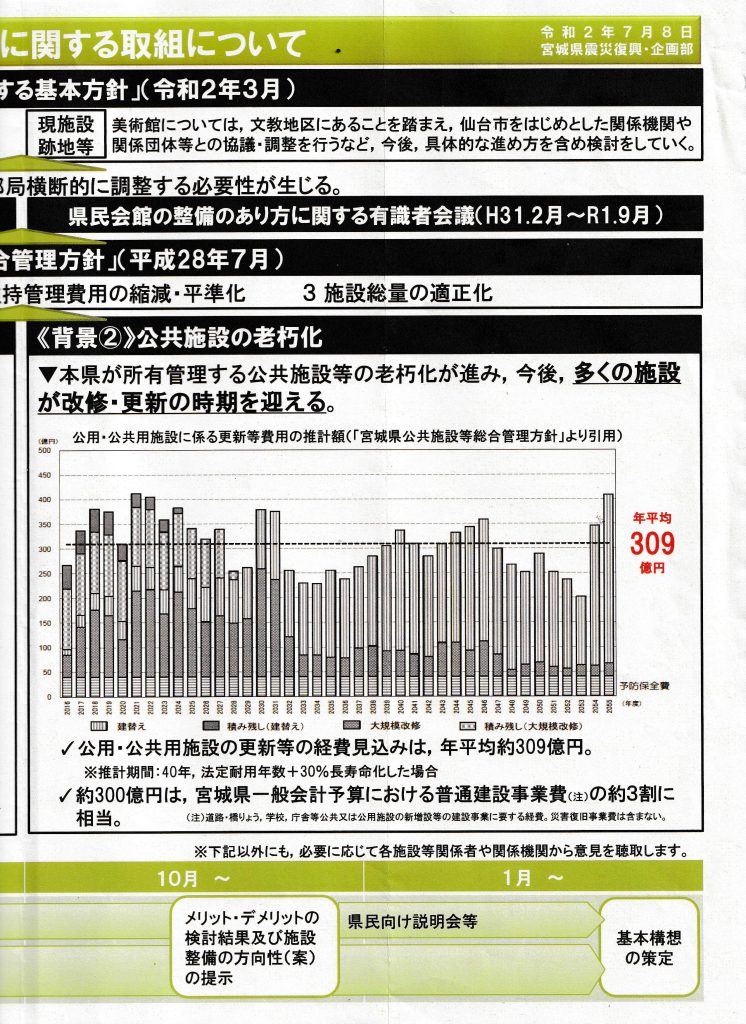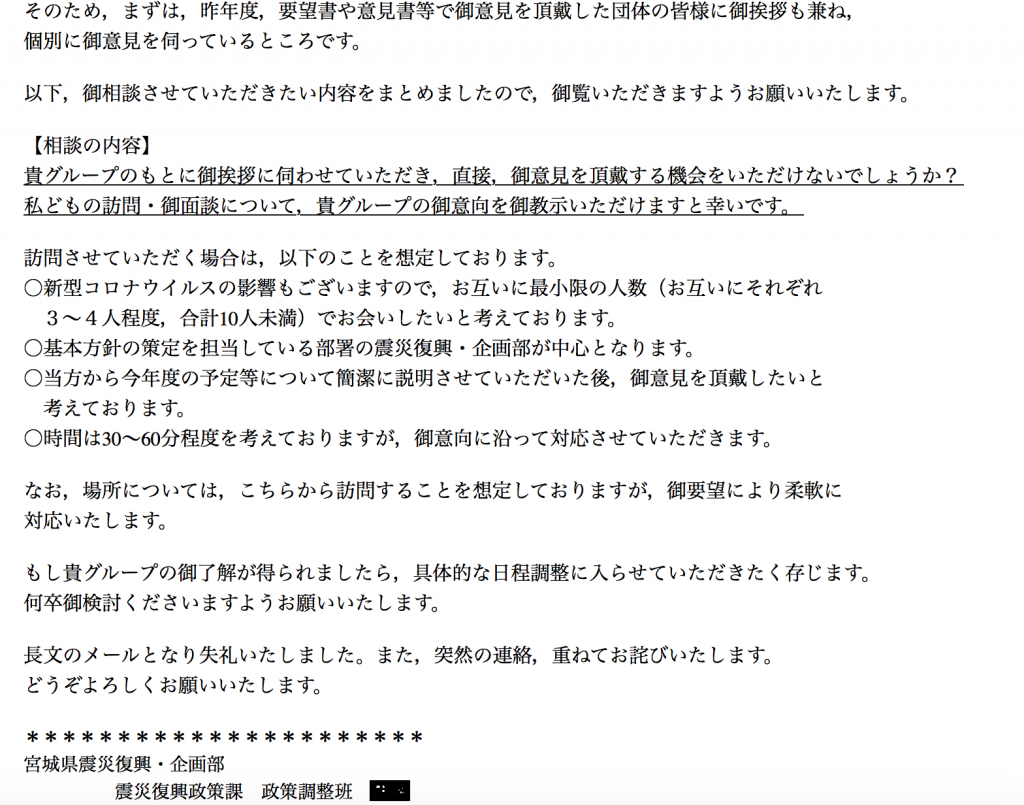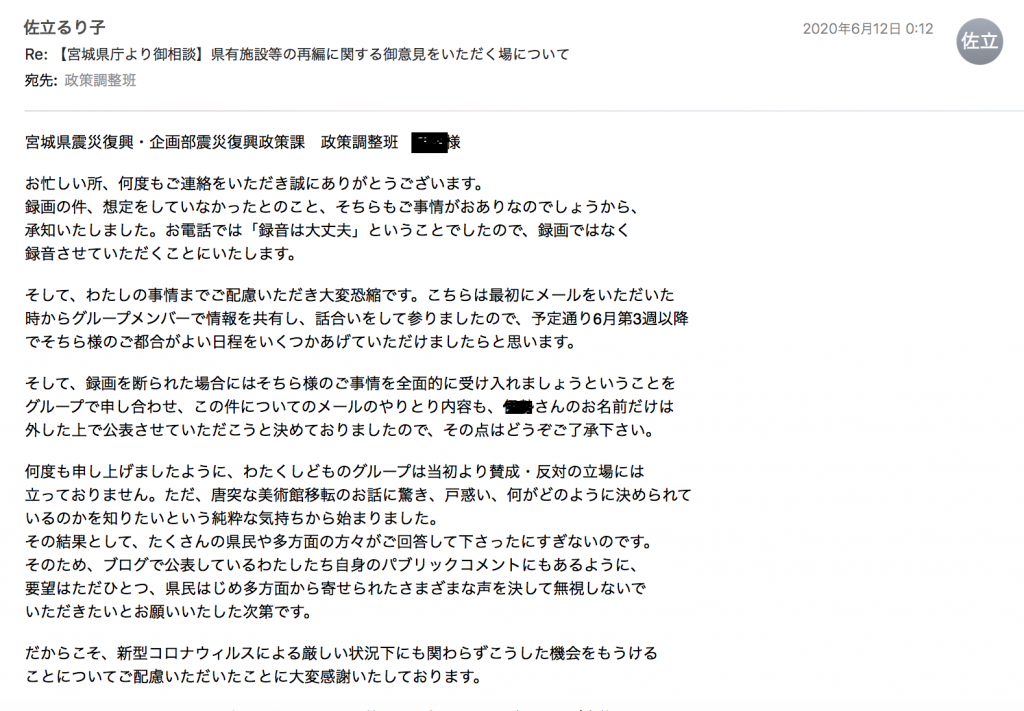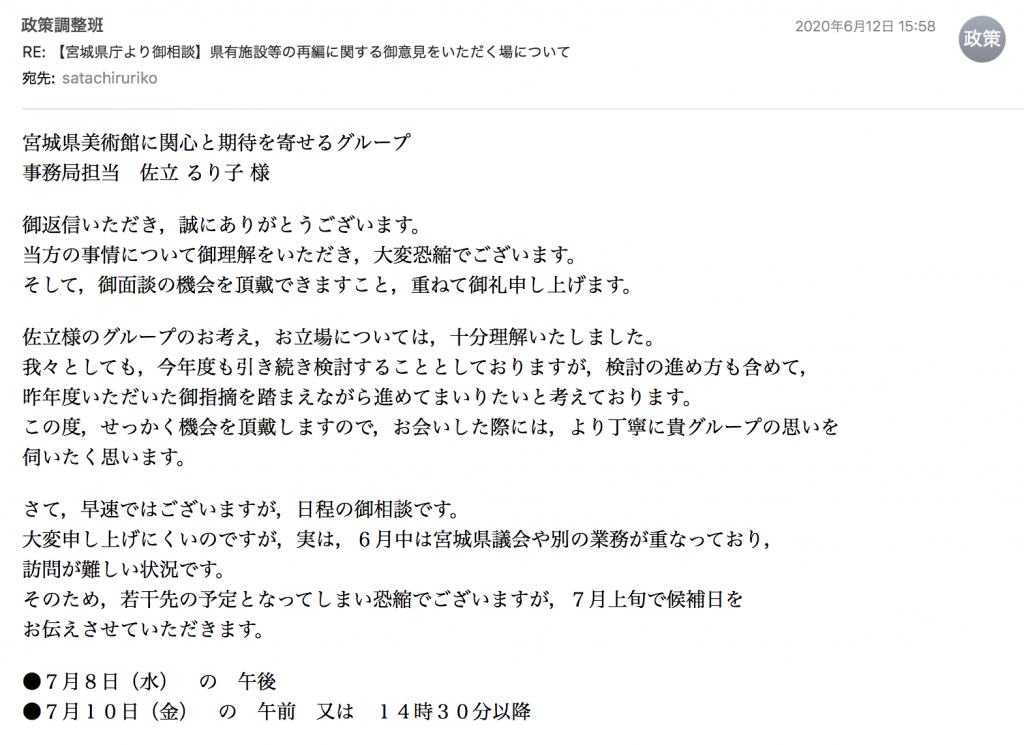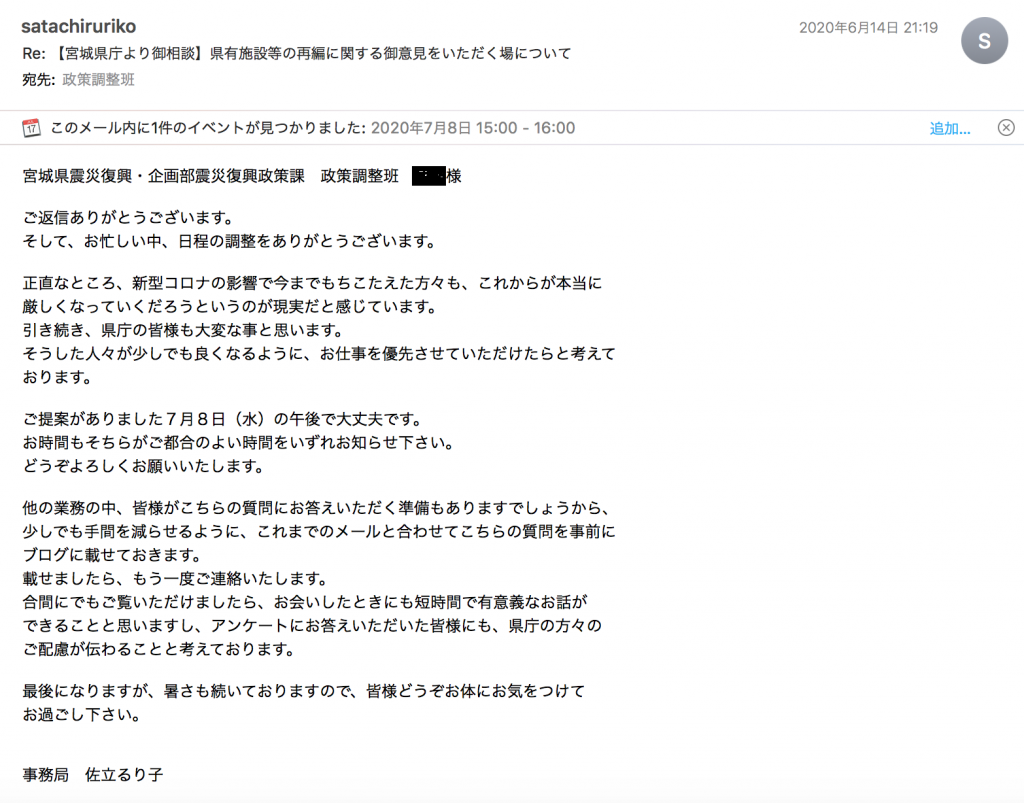We would like to express our sincere gratitude to the governor of Miyagi Prefecture and other civil servants for their efforts in combatting COVID-19. Thank you for exchanging opinions with us under these current circumstances.
First of all, we would like to confirm the following point. Are we correct in understanding that the Miyagi Museum of Art is considering both a relocation and an on-site renovation, but that no decision has yet been made?
Before posing another question, we would like to put forward the following. In the wake of COVID-19 the German Minister of Culture, Monika Grütters has stated,
“Artists are not only indispensable, but also vital, especially now.”
We agree. Therefore, we pay respect to people in architecture, music and the visual and performing arts as well as people in fine arts. Particularly, we feel that people in music and theatre are in the midst of unprecedented hardships. We sincerely hope that the situation will improve and turn out for the better.
Now, from the standpoint of the survey we conducted last December and the results of which have been made public, we would like to ask a question on behalf of those who responded. The following is quite long, but we hope you will understand its purpose.
As you may have seen, there was an enormous number of responses to the survey, and many people in various fields have already petitioned against the building of the museum, its urban development plan, and its administrative procedures.
Therefore, we just would like to ask a question about the museum itself. Since elementary school students are part of the survey, we have tried to use clear and simple language. We appreciate if you would answer in the same way.
Our one question is this.
Have you contacted Mr. Dani Karavan, the artist of Ma’ayan, whose work consists of eight pillars installed at the facade of the museum? If so, how did he reply? If you have not been in contact with him, why haven’t you?
If a decision is made to relocate, we suppose that all the sculpture and other works that are outside the museum will also be moved. But we assert that it is impossible to relocate Mr. Karavan’s Ma’ayan in particular because it is integrated with the entrance of the building. Moving it would destroy the meaning of the work altogether.
Mr. Karavan is elderly, but still living. Have you told him or his agent that there is a 1-in-4 chance that his work will be destroyed? We have heard that if the building is relocated with the help of government financial subsidies, the original building must be destroyed within five years.
If the building is not destroyed, there remains a 1-in-4 chance that it will be sold with Ma’ayan. However, depending on the purchaser, there is a possibility that there may be some modifications to the work. Even if someone purchases it, the copyright of the work belongs to the artist and the work has a right to maintain its own integrity.
The link between the artist and the contents of their work allows the artist to express their humanity. This ability to express one’s humanity is the artist’s moral right. There have been lawsuits over reasoning by which artworks were altered, such as in the case of photo parodies. There are several other instances of lawsuits, as well.
We have no idea how the contract with Miyagi Prefecture was made for the creation and installation of the work, but we are sure the artist himself would never have expected to face such a situation for a work created for the museum in such a short period as 39 years. It also came as a surprise to many of our survey respondents.
Moreover, despite the fact that the current building survived the unprecedented damage due to the Great East Japan Earthquake, a proposal to relocate and merge the Miyagi Museum of Art and the Miyagi Prefectural Hall using “The Federal Subsidy Program for the Consolidation of Facilities in Regions Facing Financial Difficulties Due to the Declining Birthrate in the next 50 years” emerged.
Perhaps because the application deadline for the subsidy program is fast approaching, there has been no discussion with art experts about what to do with the sculptures and other works. Under such circumstances, you are trying to build a new museum. How will Mr. Karavan feel when he knows the full extent of these facts?
There may be no problem if you don’t contact the him about the what steps are to be taken in accordance with his contract. But as you know, there is a well-known episode that the president of a certain large company said, “When I die, put my collection of Renoir and Van Gogh into my coffin to be cremated with me.” He was severely criticized by the British and French art circles who cried out that he intended to burn their cultural heritage to ashes. Is the governor of Miyagi Prefecture taking into consideration such a situation if this plan goes ahead?
Mr. Dani Karavan received the Praemium Imperiale in Honour of Prince TAKAMATSU award in Japan in 1998. How do the Miyagi prefectural authorities think of its cultural value? How can you decide to discard it? We believe you understand what we mean.
For your information, the artist’s introduction to Ma’ayan on the homepage of Praemium Imperiale in Honour of Prince TAKAMATSU states,
My work will die if moved to another place. Location is very important not just in terms of landscape, but in terms of history, too Please feel, listen, smell, touch, walk through with the whole body’s five senses.
At present, it is assumed that the immeasurable impact of COVID-19 will cause great harm to the future of many people around the world. In the survey, some respondents said that spending money on the arts and other activities is a waste of money. Perhaps since the survey was conducted, as they now face matters of life and death, even more people feel that way.
Some people may say that in these times there are more pressing matters. We would like to know how the prefectural government will explain the need for a new, consolidated art museum and prefectural hall complex to those people.
But we will leave this question for now. Now, we invite you to come on a journey with us for a short while. Even if we call it a journey, it is not an actual one. It is an imaginary journey. Human beings can imagine and share it.
We are sure that you have traveled around Japan and abroad. For example, when one travels to Kyoto one can see shrines, temples and statues of Buddha. Many people would like to visit the Louvre Museum in Paris and see the magnificent architecture of Gaudi’s Sagrada Familia in Spain with their own eyes. With such experiences, we are now going to travel to a small port town in Spain.
The destination is Portbou, northeast of Barcelona, near the border with France, facing the Mediterranean Sea. In the dry light of the Mediterranean climate, we are passing through a small town and going up a hill that overlooks a small bay surrounded by mountains. This is the entrance to a graveyard.
As we approach the entrance to the graveyard, we see two brown triangular metal plates sticking out of the ground near a cliff in the foreground. It is a long diagonal box that extends down the cliff through the ground. The inside of the box is so narrow that only one or two people can pass through it and down a set of steep stairs which is made of the same metal as the box’s walls and ceiling and continues downwards.
From the entrance we can see the blue ocean, cut into a small rectangle, shining in the distance below. When we go down about 80 steps, the ceiling disappears and the blue sky stretches out overhead. It feels like it is still underground because of the wall blocking the view, but beyond that we can see the blue ocean and white waves ahead.
At the end of the stairs is a dead end marked by a glass slab on which German, Spanish, Catalan, French and English text is engraved. It reads,
It is more arduous to honor the memory of anonymous beings than that of the renowned. The construction of history is consecrated to the memory of the nameless.
This work is Passage – Homage to Walter Benjamin, created by Mr. Dani Karavan at the grave of German philosopher Walter Benjamin. Benjamin, chased by the Nazis, crossed the Pyrenees Mountain on the French border and died here, where he remains buried.
Benjamin is also famous for his thoughts on the differences between traditional painting and sculpture which had previously only existed in one form, and the new media of photography and film which emerged in the modern era. The book The Work Of Art In The Age Of Mechanical Reproductionis read by many people in Japan, so we are sure many people may have heard of his name.
Cultural Anthropologist Michael Taussig wrote about this work, about Benjamin and about “the land of Spain” in detail in “Chapter 1 – Walter Benjamin’s Grave – A Profane Illumination” in his book Walter Benjamin’s Grave. This work was created in front of the entrance of the graveyard where Benjamin is buried.
From 1936 to 1939 Spain was in the midst of a violent civil war which resulted in numerous casualties, including civilians, and is known for being the subject of Pablo Picasso’s painting Guernica. Taussig wrote that there were massacres everywhere in Spain, and that the sites of the massacres were mass graves themselves. This graveyard too is one such mass grave. Passage – Homage to Walter Benjaminreveals both that fact and the fact that many that intellectuals who were pursued by the Nazis escaped to Spain and, with all hope lost, committed suicide.
We are now standing on that very same ground. In his text, Taussig tries to clarify the relationship between landscape and history. But even if it remains unclear, there is no doubt that the experience of journeying down a dark staircase to the strong light of the Mediterranean Sea will bring us some extraordinary feelings. Once again, when we turn around to go up the stairs, we can see a rectangle cut out of not the sea, but of the blue sky. And the journey ends here.
Now, let us return to the survey. 20% of respondents agree with the relocation of the Miyagi Museum of Art. They hope that the new museum will be better than it is now.
We have heard that the plans for the new museum will be discussed with art experts only after the decision is made to relocate. The museum plays an essential role not only in exhibition, but also in storage and research. We think the way in which the authorities of Miyagi Prefecture handle Mr. Karavan’s work will be a starting point for the new museum concept. Therefore, the only question we as a group would like to pose can also be posed to those in favor of relocating the museum.
And as we experienced on our imaginary journey, art expresses our human history. It is a representation of culture itself in all its forms. To protect it also means to protect ourselves. That is why, as we mentioned at the beginning, the German Culture Minister declared that artists are not only indispensable, but also vital, especially now.
Today, we understand well that now is a very difficult time for people struggling to make ends meet. That’s why we think it is important that this history remains in various forms so as to amplify the voices of people living today.
Finally, many respondents mention the museum as a place of personal memories. This may be dismissed as mere sentimentality in this relocation debate. However, we would like to remind you again the inscription on the work in far away Spain by the artist who created the only work that could be accidentally destroyed through the relocation of the Miyagi Museum of Art.
It is more arduous to honor the memory of anonymous beings than that of the renowned.
We would greatly appreciate if you would answer our one question.
Sincerely,
A group of volunteers who have high hopes and interest in the Miyagi Museum of Art
* Reference material Walter Benjamin’s Grave by Michael Taussig, Suiseisha, 2016
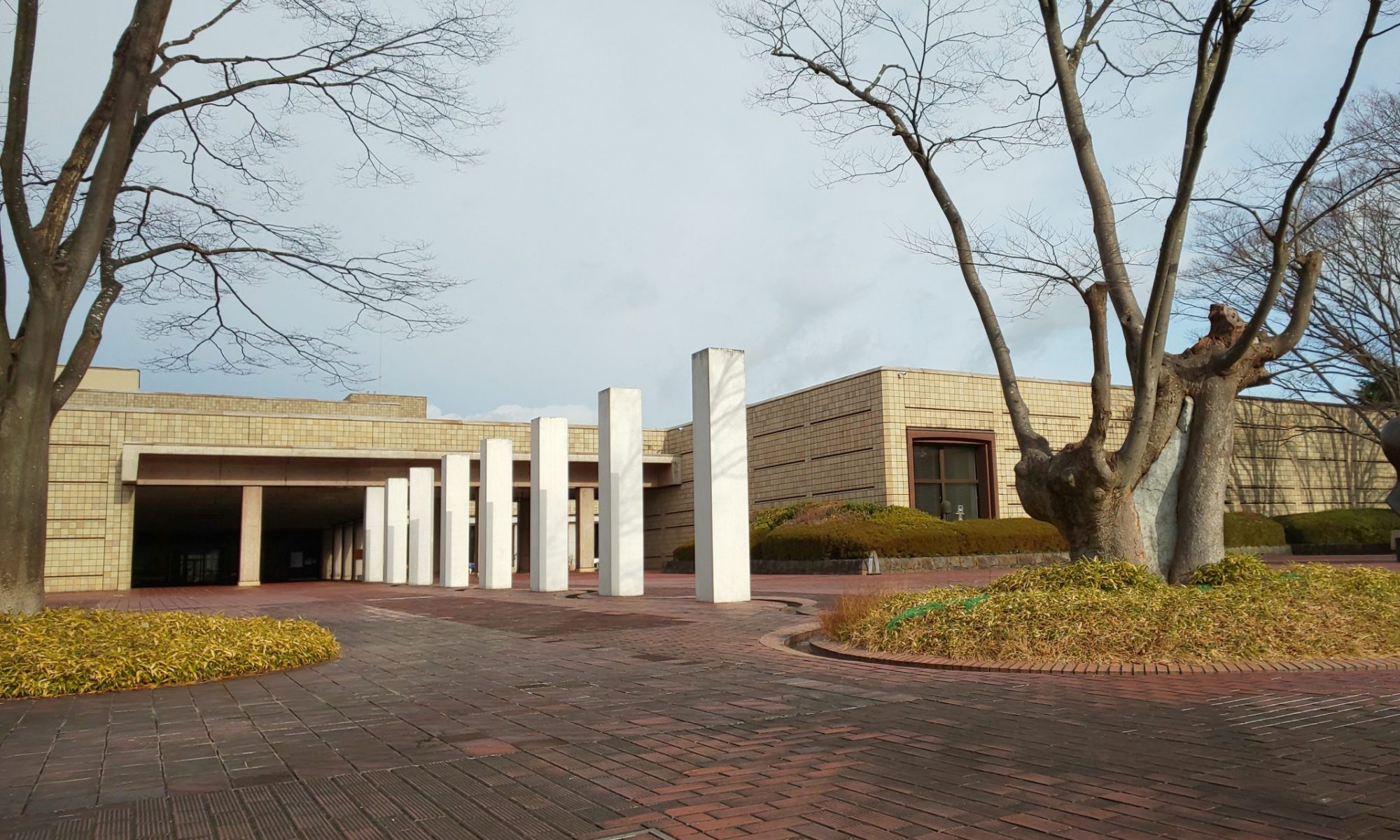
-1-2.jpg)
-2.jpg)

